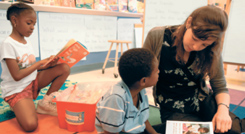Beyond the Quads
Head of the Class
Fresh out of the College and working on her teaching certificate, a Chicago UTEP student gets her feet wet in a charter school classroom.
Urban teachers are everyday heroes, out to sav the world one child at a time—in Hollywood, anyway. According to the “inspirational teacher” genre, from To Sir, With Love (1967) to Freedom Writers (2007), one dedicated teacher must stand alone, taking on the principal and the other, less inspirational teachers, while crushing rebellion in the classroom. And maybe teaching something, if there’s time.
“That is not a realistic portrayal,” says Catherine Schoenfeld, a second-year graduate student in Chicago’s Urban Teacher Education Program (UTEP). Graduates of the program earn a Master of Arts in Teaching from the Graham School and an Illinois K-9 teaching certification. “People have preconceived notions of urban schools as tough places,” she says. “They can be. But I’ve been very comfortable everywhere I’ve been so far. The kids have just been kids.”
Like the other UTEP students, Schoenfeld was admitted to the program while still an undergraduate. As a fourth-year she took three UTEP classes as electives and tutored students one-on-one in a public school, another program requirement.
One of her students, who had to repeat the second grade, was particularly challenging, Schoenfeld says. She had to work with him for three months before she won his respect. “You have to put yourself in their shoes,” she says. “He had to come in after school to do something he didn’t want to do. He was reading little-kid books. I tried to make it fun, use some humor.”
After graduating in June 2007 with a major in U.S. history, Schoenfeld was ready for the next step: her first internship. At 8:20 on a steamy July morning, Schoenfeld and a fellow UTEP intern, Emily Sayer, scrub the tables, sticky with glue from another teacher’s craft time. The classroom at North Kenwood-Oakland Charter School is sunny and colorful, with a treehouse- like “reading loft” and the usual houseplants that thrive on neglect. Carrie Walsh, the lead teacher, offers the interns some practical advice: “I always cover the tables in butcher paper.”
Walsh leaves and soon returns with twelve squirmy second-graders—eight boys and four girls. The summer school class is designed to give these kids some extra help in math and reading. By 8:35, each child is sitting on a square of the brightly patterned rug for their hour-long “morning meeting.” Schoenfeld, Sayer, and a third intern, Jason Sitko, sit on tiny chairs behind the children, observing the class. One child has brought a plastic cup of caterpillars to show. Later the children slip off their shoes and do yoga.
By 9:35, just as the kids are getting squirmy again, it’s “center time.” The children take turns at four centers: ABC (word-writing practice), journal, math, and browsing books. For the UTEP interns, it’s their main time to interact with the children. Schoenfeld and the other interns circulate, encouraging and cajoling.
At the browsing books center, the children practice reading aloud. After saying the words, the children—in a perfect imitation of Walsh—turn the books outward and show the pictures to an imaginary class.
“Miss Catherine,” as the children call her, is listening to Xavier read “The Three Little Pigs.” In Xavier’s version, when the wolf comes down the chimney, “the pigs had a prize for him.”
“A what?” Schoenfeld asks gently.
Xavier looks again. “A surprise.”
“What’s the surprise going to be?”
“His tail’s gonna burn up!” Xavier says gleefully.
In the math center, the children are playing a card game similar to snap, using cards that also have dots and polygons. The kids seem to find this activity the most compelling of the four, though it is also causing the most friction in the otherwise peaceful classroom.
“So what do you say?” Schoenfeld asks Justyn, winner of the last round.
“Thank you,” Justyn guesses.
“And…?”
“I’m happy!”
“And?”
“I wish you beat me next time.”
“Or you could just say ‘good luck,’” Schoenfeld suggests.
“Good luck.”
According to Kavita Kapadia, UTEP program director, the student-teachers are encouraged to see children’s strengths. In contrast, the so-called “deficit approach,” Kapadia explains, focuses on such perceived deficiencies as nonstandard English, and “locates difficulties and problems in students and families themselves, rather than on the circumstances around them.”
A former Chicago Public Schools (CPS) teacher, Kapadia is no naïve idealist. She came to Sawyer Elementary on the Southwest Side as an experienced teacher, having taught for five years in Arlington Heights. If she found the job so tough,Waitshe wondered, how were new teachers coping? UTEP graduates are not required to teach in CPS, but many do. One powerful incentive is the two years of coaching that graduates receive, including classroom visits. Teachers who leave Chicago are still eligible, but the support is online rather than in person.
Before applying to UTEP, Schoenfeld considered Teach for America and Chicago Teaching Fellows, programs that throw bright but untested teachers into the classroom with little formal training. “I didn’t think I would be well enough prepared,” says Schoenfeld, who “ideally” would like to teach in CPS. “I wanted a realistic approach to teaching in urban schools. Experience and support—that’s what it takes.”—Carrie M. Golus, AB’91, AM’93
